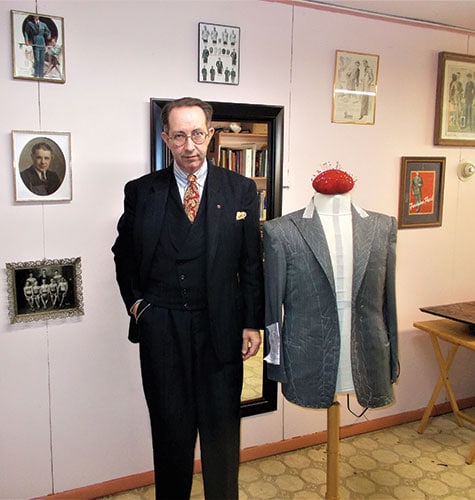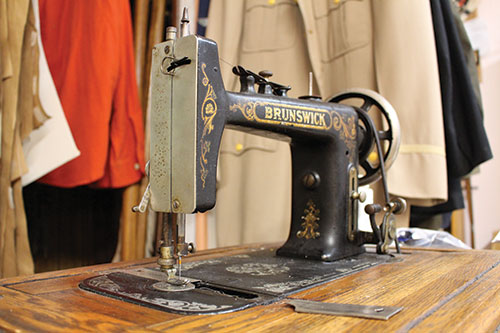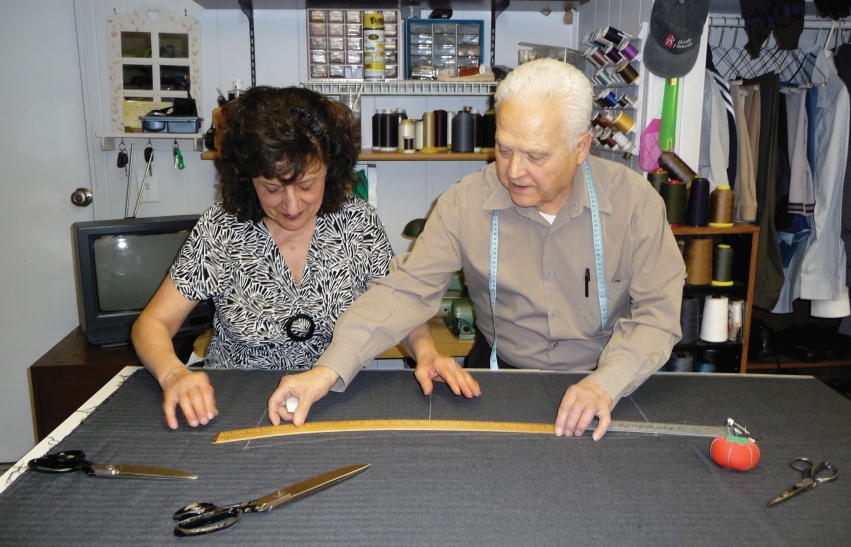Custom tailoring and alterations help consumers find their unique style and attain that perfect fit.
"Good hallmarks to look for would be pad stitching on the lapel, full canvassing, hand-sewn collars—those are things that are actually fitted right to the suit as you’re building.” Josef Kleffman, master cutter and tailor at Timeless Tailoring, runs his hands over the lightly pinstriped blue wool he’s cut and stitched by hand, pointing out the features of a well-made suit jacket. “Functional sleeve buttons, [pattern] matched seam lines—it’s all about the little details,” he explains. “But people do notice those things.”
Kleffman is one of the few in the area specializing in the exclusive service of bespoke tailoring for menswear—clothing that’s custom-made to an individual’s measurements and style. Often associated with the colorful history and high-end designers of London’s Savile Row, it’s an old tradition making a quiet comeback, along with other personalized alternatives to retail clothing.
As online sales continue to transform the clothing industry, there’s been a resurgence in custom wear, perhaps to counter the “fast fashion” phenomenon of trendy, cheap clothing that’s practically disposable (think H&M, Topshop or Forever 21). Technology has made it possible for retailers like Men’s Wearhouse and online shops like eShakti to offer affordable made-to-order options for a middle market that’s hungry for customization. But sales of bespoke clothing have been on the rise in recent years despite the higher price point, while tailored alterations of retail or secondhand clothing provide another way to obtain the perfect fit. Hand tailoring appeals to discerning consumers seeking high-quality customization—as well as a personalized experience.
 Traditional Techniques
Traditional Techniques
Kleffman learned how to sew and tailor from his grandmother, Corinne, who worked as a modiste in downtown Peoria before leaving to work in her father’s machine shop, first during World War II and then in the Korean War. When Kleffman’s sister showed no interest in learning the trade, his grandmother began teaching him the basics: all the different hand stitches, buttonholes, collars and sleeves, how to make the canvas foundation and build a garment to the client’s form. After apprenticing with her for four years, Kleffman pursued other career options, but began tailoring on the side in 2005. When his former employer closed its doors in 2014, he decided to make it a full-time business.
Kleffman works out of a small studio behind his modest home in Marquette Heights, spending anywhere from 20 to 80 hours per commission, with suits typically priced at $2,000 or more depending on the chosen fabric. To his clients, the suits are an investment. They value the quality of his work, knowing their one-of-a-kind garment will last 10 to 12 years or more.
After discussing the client’s style and needs, Kleffman takes more than 40 measurements and then drafts the design by hand—often referring to a vintage copy of Tailor & Cutter magazine for classic pattern forms. The paper pattern is then laid, cut to the fabric and basted together to form the suit’s foundation. During the first fitting, the chest canvas and shoulder padding are shaped to the body, while meticulous adjustments are made to the jacket, trousers and vest in subsequent fittings. Pockets, linings and sleeves are added piece by piece, along with inlays for future alterations.
Kleffman’s suits are fully canvassed with high-quality fabric made from horse hair for structure that conforms to the wearer’s body, and they feature authentic trimmings like silk thread and horned buttons. Much of this work is done by hand, though Kleffman uses a 1928 Brunswick sewing machine for certain seams. This “old-fashioned” process of construction ensures the garments will endure the wear and tear that comes with frequent use, travel and all seasons of weather.
Some clients arrive with specific ideas of the style they want, which Kleffman is happy to accommodate. He loosely follows fashion trends, but generally advises for classic cuts and elements that will best flatter the client’s features. “I prefer style that is timeless, where no one part of the suit outweighs the other and everything is in harmony,” he explains, pointing to the drape cut that was popular in the 1930s for broadening the shoulder.
 His clients come from different backgrounds and professions, with various reasons to add smart, distinctive pieces to their wardrobe. Some need to dress to impress, while others are simply tired of off-the-rack clothing that doesn’t fit well or last long. And while Kleffman specializes in menswear, he’s slowly growing his female clientele and offers services like invisible mending as well. He prides himself on quality and customer service, often traveling to Chicago or working a weekend to accommodate his clients’ schedules. “I've had people tell me, ‘You know, your tailoring techniques are a little dated,’” he says. “I don't disagree—but I guarantee that the things I make will still be around for years to come.”
His clients come from different backgrounds and professions, with various reasons to add smart, distinctive pieces to their wardrobe. Some need to dress to impress, while others are simply tired of off-the-rack clothing that doesn’t fit well or last long. And while Kleffman specializes in menswear, he’s slowly growing his female clientele and offers services like invisible mending as well. He prides himself on quality and customer service, often traveling to Chicago or working a weekend to accommodate his clients’ schedules. “I've had people tell me, ‘You know, your tailoring techniques are a little dated,’” he says. “I don't disagree—but I guarantee that the things I make will still be around for years to come.”
Familial Patterns
Here in Peoria, Ghantous is a well-known name in the tailoring business, passing down their craft for generations. Dumit Ghantous learned the family trade as a youth in Lebanon, and when he married his wife Anna, they combined their expertise—Anna specialized in women’s wear, Dumit in bespoke menswear—to provide full-service tailoring. They started working the day after their arrival in Peoria in 1956, despite the language barrier, and eventually opened their own shop on West Main Street. For nearly four decades, D. Ghantous Tailoring has operated out of a brick home on Clarewood Avenue near University Street, now proudly run by their daughter, Janet Salem.
For Salem, carrying on the family tradition was a natural choice. “Mom and Dad were the best at what they did,” she explains. “I enjoyed the work so I decided to join them, and I’ve been doing alterations with them for 38 years now.” While the Ghantouses once made custom suits and wedding gowns, they now specialize in alterations and made-to-order garments (they take the measurements, while the clothing is made by trusted vendors in New York or Chicago), but will still occasionally make custom costumes, children’s clothing, drapery and other items that aren’t as time-consuming.
The Ghantous tailoring tradition extends beyond her immediate family, as Salem’s parents helped relatives from Lebanon get established in Peoria. “It really is a family business. Two of my uncles, my brothers and one of my cousins do alterations, too,” Salem notes. “We share referrals and we’re all happy to help each other out when needed.”
Their clientele is often generational as well—Salem says that grandchildren of her parents’ clients still come to them. “We've had people come from Chicago for alterations because their parents or grandparents loved our workmanship and our ethics.” She believes the quality of their work and the time they spend with clients for fittings sets their business apart. “They know we’re not going to take any shortcuts.”

Anna and Dumit Ghantous at work in their Peoria shop. Photo courtesy of the Ghantous family
While the shop sees a steady flow of customers, Salem says they’re busiest from February to May with work for proms, graduations, weddings and other special occasions. One trend she’s noticed is that more people are buying items online or from secondhand stores, then bringing them in for alterations—an affordable way to personalize their style and obtain that perfect fit. In addition, more people are bringing in clothes to be mended in order to extend the life of the garment. “Times are definitely changing,” she notes. “You can get some really great deals on beautiful clothing from secondhand stores that just needs to be fixed or fitted.”
Tasteful Matters
Clothing style can certainly define an individual and impact how others perceive them. And while an evolving fashion and retail industry means an abundance of choice and opportunity, endless options can overwhelm. The online experience will never replace the guidance and one-on-one attention of a good tailor or the quality of a garment sewn with care. Good clothing indicates good taste, and as Kleffman says, “Fashions change, but real style is timeless.” a&s
For more information about Timeless Tailoring and D. Ghantous Tailoring, find them on Facebook or visit timelesstailoring.wix.com/tailor and ghantoustailoring.com. Read "Method of Measurement" on the PS Blog for a detailed account by Josef Kleffman of his traditional bespoke tailoring technique.


